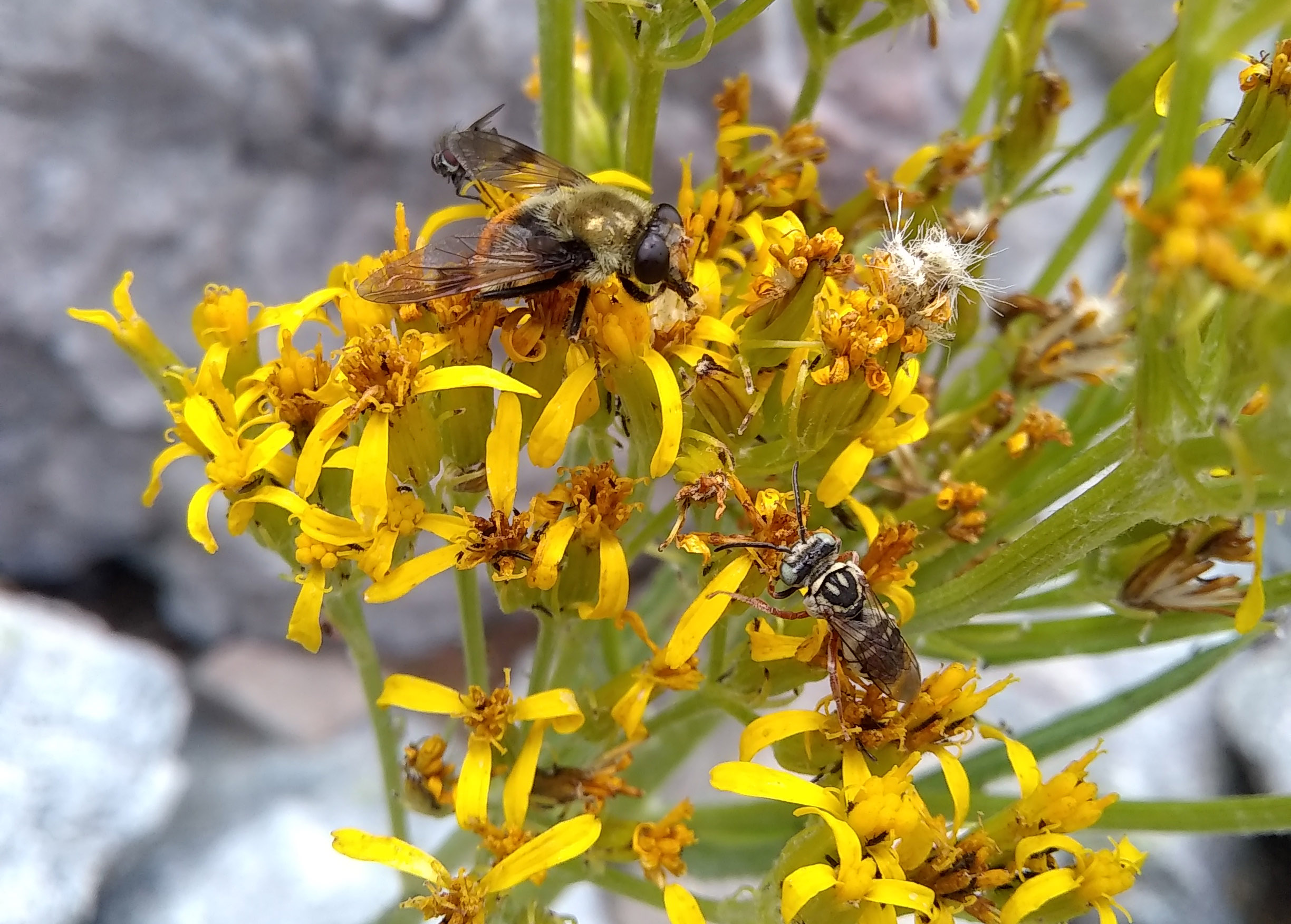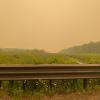With more than three hundred species of butterflies and around one thousand species of bees, New Mexico boasts an impressive diversity of pollinators. This diversity is driven by the variety of landscapes and plant communities within New Mexico: the state encompasses the continental divide and the convergence of several major ecoregions, including the Rocky Mountains, the Great Plains, the Chihuahuan Desert, and the Colorado Plateau. From alpine meadows to desert dunes, pollinators of all shapes and sizes can be found visiting the unique flora of New Mexico.

A flower fly (Sericomyia flagrans) and cuckoo bee (Triepeolus sp.) nectaring from a Wooton’s ragwort (Senecio wootonii) in the Sangre de Cristo Mountains of northern New Mexico. (Photo: Kaitlin Haase.)
Pollinators of this region face the same threats that affect pollinators on a global scale: habitat loss, pesticide use, diseases and nonnative species, and climate change. Of these, climate change is particularly threatening in the Desert Southwest, with rapidly rising temperatures and increasing severity of droughts already occurring in the region. Fortunately for pollinators, the Xerces Society expanded its pollinator conservation efforts this year by adding a new regional position, the Southwest Pollinator Conservation Specialist, based in Santa Fe, New Mexico. Since the beginning of this position in May, I have been delighted to discover that many New Mexicans are concerned about pollinator decline and are eager to do whatever they can to conserve pollinators, even in the midst of a global pandemic!
This summer, we partnered with the NMSU IPM program to host a 6-week webinar series, Supporting Pollinators and Beneficial Insects in Backyards and Farms, which more than 100 people from New Mexico and beyond attended each week. We also hosted a webinar on Monarchs and Milkweed in New Mexico this fall, and will host two more, on rangeland management for pollinators and building pollinator habitat in cities and towns, this December. Keep an eye on the Xerces Society events page for details and registration!
As part of our work to promote urban pollinator habitat in the Southwest and to provide locally appropriate conservation information, we are working with local native plant specialists and pollinator ecologists to develop a list of recommended pollinator-friendly native plants for the Albuquerque and Santa Fe region. This list features climate-resilient species that will attract a diversity of pollinators, including native bees, butterflies, and moths. We hope to produce similar plant resources for other regions in New Mexico and the broader Desert Southwest in future (plant lists for many other regions of the United States can be downloaded from the plant lists page of our website).

Olivia Carril, Santa Fe resident and author of The Bees in Your Backyard, highly recommends annual sunflower (Helianthus annuus) as an easy-to-grow native plant that will attract a diversity of our native bee species, such as this long-horned bee. (Photo: Xerces Society / Kaitlin Haase.)
While Xerces is just beginning to establish roots in New Mexico, many local organizations, communities, and individuals have been working to conserve the Southwest’s natural landscapes for years, providing rich opportunities to build collaborations for pollinator conservation. The Nature Conservancy and the Audubon Society have established preserves of natural areas in New Mexico, and the Friends of Valle de Oro National Wildlife Refuge has a Backyard Refuge program to encourage residents of Albuquerque to build urban habitat corridors, all of which provides natural parallels for our work to conserve pollinators across urban and natural spaces. A local nonprofit I have enjoyed collaborating with is the Southwest Program for the Institute for Applied Ecology (IAE). This year, the Southwest IAE team established a native pollinator planting at the Salinas Pueblo Missions National Monument. I was fortunate enough to get some soil and sun exposure by helping with the plantings for two gardens at the visitor centers at the Abό and Quarai sites, and will be assisting with their interpretative sign development for these gardens.

Blanket flower (Gaillardia pulchella) stands out in this freshly planted pollinator garden at the Abó site of the Salinas Pueblo Missions National Monument. (Photo: Xerces Society / Kaitlin Haase.)
Excitement and momentum around pollinator conservation efforts are definitely growing in New Mexico. This summer, the Santa Fe County commissioners unanimously passed a pollinator protection resolution directing county staff to explore several pollinator conservation initiatives. The county’s Open Space, Trails, and Parks program is working with the Xerces Society to develop pollinator habitat plans for several open space properties and plans for wildflower seeding trials. In 2021, we will work with both the City of Santa Fe and Santa Fe County to promote and build urban pollinator habitat through the launch of the Santa Fe pollinator trail, highlighting and supporting properties in the Santa Fe area which provide pollinator-friendly gardens and open spaces. I look forward to deepening our partnerships in New Mexico and working together with gardeners, farmers, legislators, nonprofits, and others to protect and restore landscapes that support the diversity of pollinators across the state.
Further Reading
- Xerces Society's Albuquerque and Santa Fe Pollinator-Friendly Native Plant List
- Pollinator Plant Recommendations for New Mexico (USDA NRCS Plant Materials Center, Los Lunas, NM)
- Pocket Guide to the Native Bees of New Mexico (New Mexico State University)




